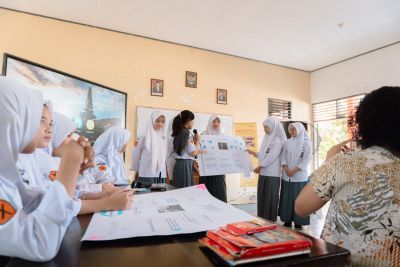How can we create an environment that supports mental health?
Young people voiced their responses to the question:
How can we create an environment that supports mental health?
The winning entries of the BASAsulsel Wiki Mental Health Wikithon emphasize the importance of creating environments that support mental well-being—whether in schools, families, communities, or public spaces. In schools, initiatives such as quiet corners, peer support programs, and the use of mental health-friendly technologies are seen as effective ways to build safe and empathetic environments. Within families, open communication, emotional support, and simple forms of togetherness—such as sharing meals—have proven to enhance the mental resilience of family members. In the community context, the “Mindful Village” concept encourages people to redesign public spaces such as parks and sidewalks as areas for reflection and calm, while incorporating local traditions such as gotong royong (mutual cooperation). Furthermore, personal education on mental health, the application of local values like sipakatau (mutual respect) and sipakainge (constructive reminders), and the strengthening of stigma-free social relationships contribute to greater social solidarity. Awareness of the importance of recognizing symptoms of mental health disorders—such as mood changes or disrupted sleep patterns—and the role of clean and healthy environments in fostering inner peace is also emphasized. Altogether, these solutions reflect that mental health is a shared responsibility that can begin with small, empathetic actions in our everyday surroundings. There are five key points that summarize the participants’ ideas as essential factors in supporting mental health: 1) Emotionally and socially supportive environments, whether at home, school, or in the community, safe, empathetic, and stigma-free spaces are vital for sustaining mental health; 2) The role of family and peers as primary support systems. Open communication, togetherness, and emotional support from close relations help individuals cope with life’s pressures; 3) Utilizing technology and public spaces for mental health. Mental health apps, reflective space design, and calming community activities like meditation and “Silent Hour” can strengthen inner well-being; 4) Education and self-awareness as foundational elements. Recognizing early signs of mental health issues and fostering habits of self-care and care for others are powerful preventive measures; 5) Strengthening local values and culture. Traditional values such as sipakatau and gotong royong can be integrated into efforts to build inclusive and mentally healthy environments.
Winning entries led to this Policy Brief:
The Issue does not have Policy Brief created yet.
Young women and men came together with government officials to discuss the Policy Brief in a series of Policy Dialogue:
Policy Dialogue
The Policy Paper will generate discussions from a range of policymakers that will be broadcast for transparency, accountability and public input.
As a result of the Policy Dialogue, young people and government agreed to implement the following measures. The measures includes evaluation and compliance components:
The Issue does not have Implementation created yet.

